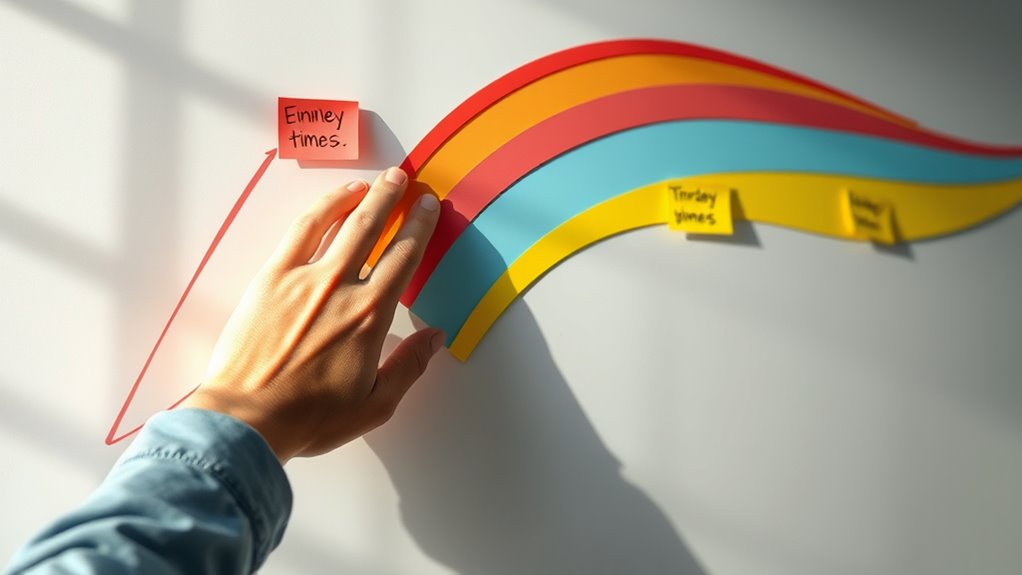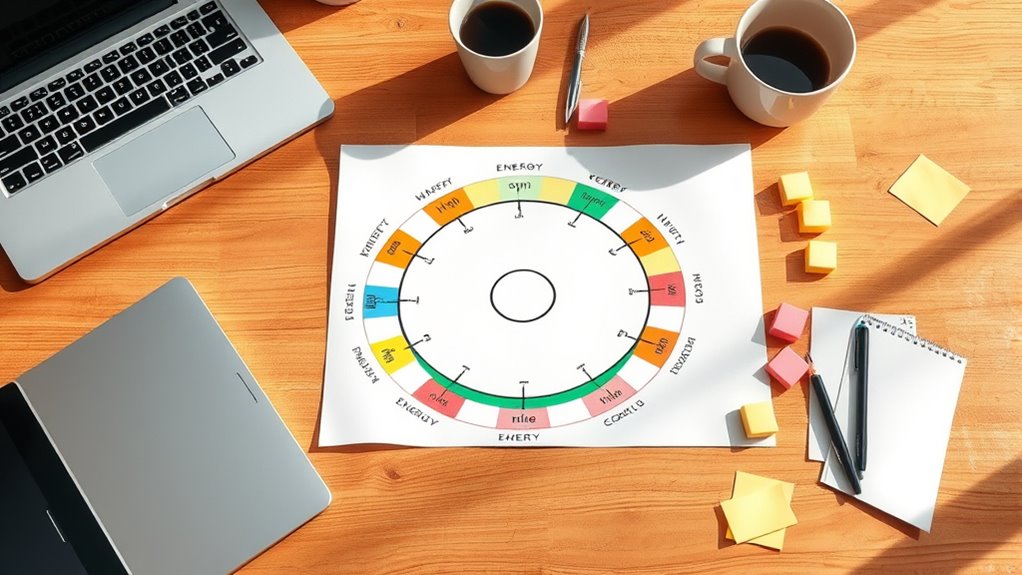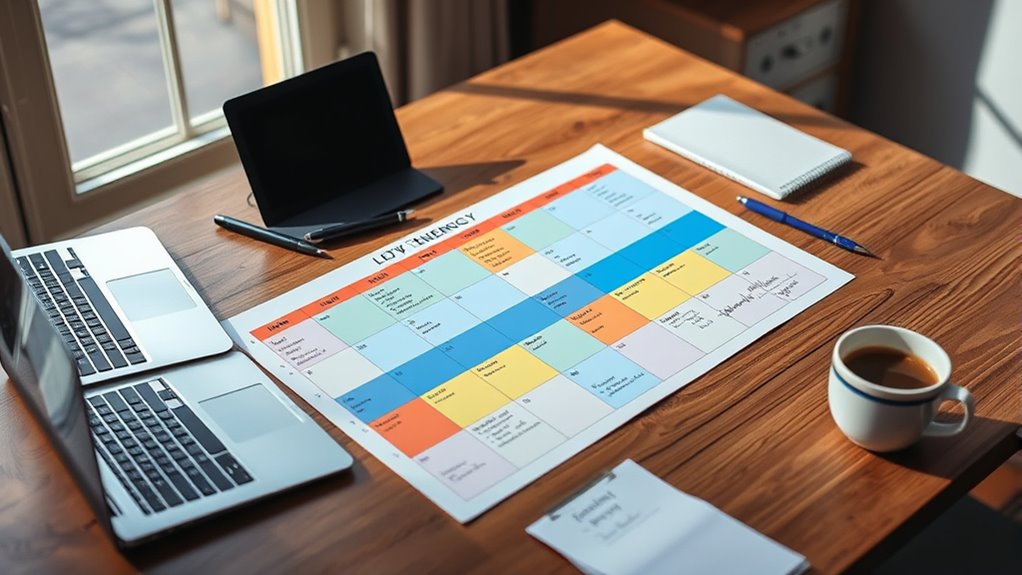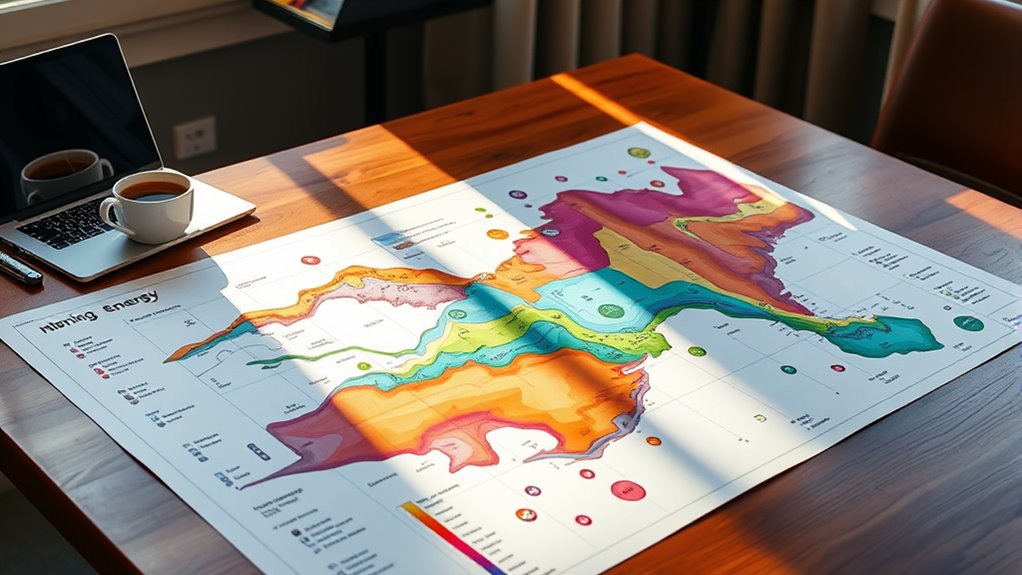To design your personal energy map for the week, start by monitoring your alertness peaks and dips throughout each day. Track how sleep, food, and hydration influence your energy levels, noting both high and low periods. Map these times to schedule demanding tasks during your natural energy highs and routine work during lows. Regularly review your patterns and adjust your plan as your energy shifts, helping you stay balanced and productive all week long. Keep exploring to refine your approach even further.
Key Takeaways
- Track daily energy levels and identify peak alertness times to optimize task scheduling.
- Monitor factors like sleep, nutrition, and hydration to understand their impact on your energy fluctuations.
- Map high and low energy periods to assign demanding tasks during peaks and routine work during lows.
- Plan your weekly schedule by aligning complex tasks with high-energy periods and administrative tasks with lower-energy times.
- Regularly review and adjust your energy map based on recent patterns and lifestyle changes for ongoing effectiveness.
Identifying Your Natural Energy Patterns

Understanding your natural energy patterns is essential for optimizing your weekly schedule. When you identify your energy flow, you can align tasks with your productivity peaks, making the most of your energy. Pay attention to when you feel most alert and focused, whether it’s mornings, afternoons, or evenings. Recognizing these patterns helps you plan demanding tasks during high-energy periods and save less intensive activities for when your energy dips. Tracking your energy levels over a week reveals consistent trends, allowing you to tailor your schedule effectively. By understanding your natural rhythms, you prevent burnout and boost overall productivity. Incorporating performance metrics into your assessment can provide a clearer picture of your energy fluctuations. This awareness empowers you to create a balanced weekly plan that maximizes your strengths and respects your body’s natural flow.
Tracking Your Energy Levels Throughout the Day

Tracking your energy levels throughout the day is a crucial step in optimizing your productivity. Pay attention to how your sleep quality influences your energy, noting days when you wake up refreshed versus fatigued. Your nutritional habits also play a key role; notice how meals and snacks impact your alertness and focus. Keep a simple log, recording times of high and low energy, and jot down relevant factors like sleep duration, food intake, and hydration. This tracking helps you identify patterns and triggers that affect your daily energy fluctuations. Incorporating mindfulness practices into your routine can further enhance your awareness of these patterns and support your overall well-being. By understanding these connections, you can make informed adjustments to your sleep routine and diet, ultimately boosting your overall productivity and well-being.
Mapping Your Peak and Low Energy Times

Once you’ve started noting how your energy levels fluctuate throughout the day, the next step is to identify when you experience your highest and lowest points. Pay attention to your energy highs, the times when you’re most alert, focused, and motivated. These are your productivity peaks, when tasks feel easier and your output is at its best. Conversely, recognize your low energy times, when you feel sluggish or distracted. Mapping these patterns helps you understand your natural rhythms, so you can schedule demanding tasks during your energy highs and reserve less intensive work for your lows. This awareness allows you to optimize your day, working smarter, not harder, by aligning your activities with your energy highs and lows. Incorporating time management skills into your routine can further enhance your ability to capitalize on these energy patterns.
Planning Your Weekly Schedule Around Your Energy Map

After identifying your peak and low energy times, you can strategically plan your weekly schedule to maximize productivity and conserve energy. Mindful scheduling helps you align tasks with your natural energy patterns, ensuring you’re focusing on demanding activities when you’re most alert. By practicing energy awareness, you avoid burnout and maintain consistent progress. Consider these approaches:
- Tackle complex tasks during high-energy periods for better focus.
- Reserve low-energy times for routine or administrative work.
- Schedule breaks and progressions to recharge and reset.
- Prioritize important meetings when your energy is at its peak.
- Remember that understanding retail hours today can help you plan errands efficiently and avoid unnecessary stress.
This intentional planning creates a balanced week, reduces stress, and keeps you aligned with your energy flow. Staying mindful of your energy map helps you work smarter, not harder, fostering sustainable productivity.
Adjusting and Refining Your Energy Map for Continuous Balance

To maintain a balanced energy map, you need to regularly review and adjust your insights based on your evolving patterns and experiences. This ongoing process guarantees your energy optimization strategies stay effective. Incorporate mindfulness practices to stay aware of your energy shifts and refine your map accordingly. Use the following table to track recent changes and adapt your plan:
| Observation | Adjustment Needed |
|---|---|
| Morning energy dips | Schedule lighter tasks |
| Afternoon slump | Add short breaks |
| High energy days | Tackle demanding projects |
| Low motivation | Practice mindfulness |
| Sleep disruptions | Adjust evening routines |
Frequently Asked Questions
How Often Should I Revisit My Energy Map?
You should revisit your energy assessment at least once a week during your weekly review. This helps you identify patterns, adjust your schedule, and optimize your energy levels. Regularly checking in guarantees your energy map stays accurate and relevant, allowing you to make informed decisions about when to rest or focus on high-energy tasks. Consistent reviews empower you to maintain balance and productivity throughout the week.
Can External Factors Affect My Energy Patterns Unpredictably?
External influences can definitely cause unpredictable energy fluctuations. Sudden changes like weather, social events, or work demands might impact how you feel throughout the day. You might notice dips or spikes in your energy that aren’t part of your usual pattern. Staying aware of these external influences helps you adjust your plans accordingly, so you can maintain better control over your energy levels, despite unpredictable shifts.
What Tools Are Best for Tracking Energy Levels?
When tracking your energy levels, consider using energy tracking apps and wearable devices. These tools help you monitor patterns, identify triggers, and understand your energy fluctuations better. Energy tracking apps offer easy logging and insights, while wearable devices provide real-time data on activity and rest. By consistently using these tools, you can optimize your daily routines and improve your overall energy management effectively.
How Do I Handle Inconsistent Energy Patterns?
Imagine you notice your energy fluctuates unpredictably. To handle this, you can build resilience by adjusting your schedule—reserving demanding tasks for high-energy periods and relaxing during lows. Tracking your patterns helps you anticipate dips, making it easier to adapt. Consistent self-care and mindfulness also strengthen resilience, allowing you to navigate energy fluctuations more smoothly. Over time, this approach helps you maintain productivity despite inconsistent energy levels.
Is There a Way to Boost Low-Energy Periods Naturally?
When your energy dips, you can naturally boost it by making simple diet adjustments, like eating balanced meals with protein and complex carbs, and staying hydrated. Also, practice mindful breathing techniques to increase oxygen flow and reduce stress. These strategies help stabilize your energy levels without relying on stimulants, allowing you to feel more alert and focused throughout the day. Consistent use can improve your overall energy resilience.
Conclusion
By designing your personal energy map, you’re setting yourself up for success. When you understand your natural rhythms, you can work smarter, not harder. Remember, it’s a journey, not a one-time task—expect to tweak and refine along the way. Think of it as finding your groove; once you do, everything falls into place. Keep listening to your body, and you’ll stay on top of your game, no matter what the week throws at you.









